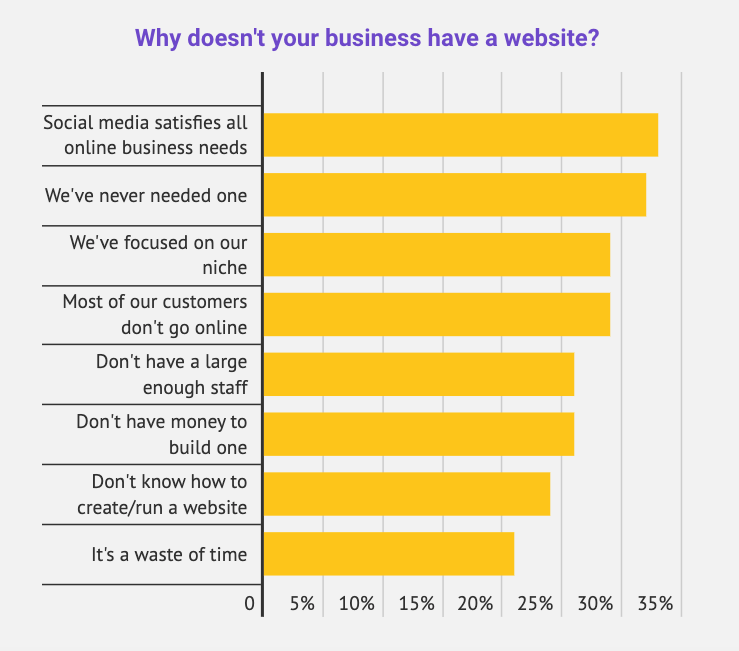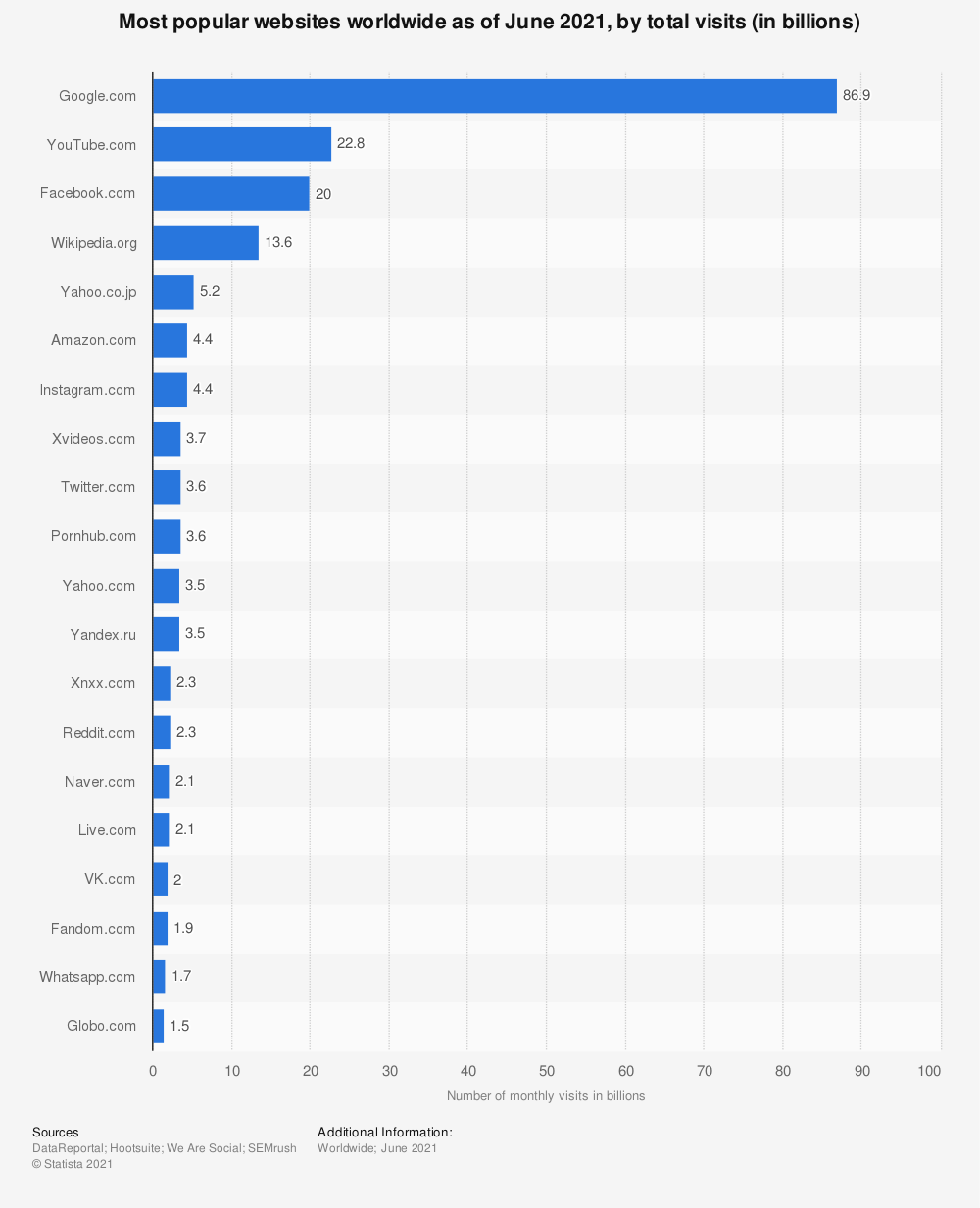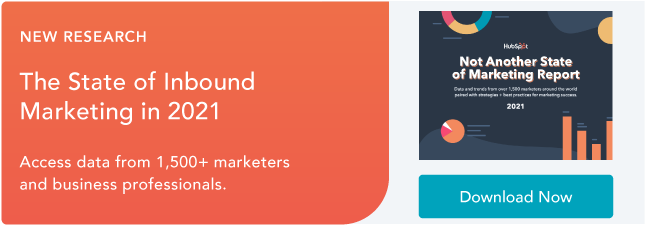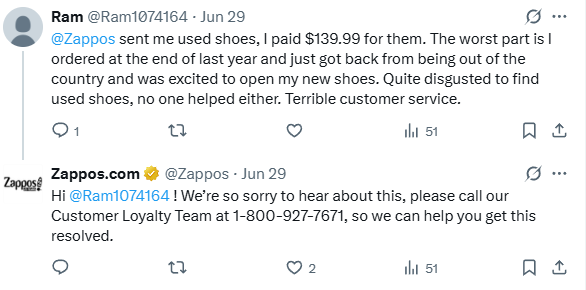In 2010, there were over 2 billion internet users worldwide. In 2021, there were over 4.6 billion.
To attract and engage this growing base of online users, websites are being created at a rapid pace. In 2010, there were a little over 210 million websites. Today, there are over 1.8 billion.
To stand out in this crowded online space, you need to understand the latest technologies and trends in web design, as well as consumer behaviors and expectations. To help, we’ve covered the most essential web design statistics of 2021. Let’s get started.
Web Design Statistics
Mobile Web Design Statistics
1. In the first quarter of 2021, mobile devices generated 54.8 percent of global website traffic. (Statista, 2021)
Mobile traffic has been hovering around the 50 percent mark since the beginning of 2017. That means it’s more important than ever to optimize your website for mobile devices as well as desktops. It’s also important to consider whether offering a mobile app would provide a better experience to your users.
2. 32% of small businesses already have a mobile app and 42% plan to build one in the future. 26% of small businesses, on the other hand, are unlikely to ever release one. (Top Design Firms, 2021)
Some small businesses have already created a mobile app, while others plan to in order to improve their customer service or streamline the purchasing process for their customers. But over a quarter of some small businesses aren’t planning to — now or ever. Some don’t have the budget or marketing capabilities to create and promote their app. Others don’t think it makes sense for their business or audience.
Whether your small business should invest in building a mobile app or not depends on a wide range of factors, including your industry, target audience, and budget.
3. 50% of smartphone users are more likely to use a company or brand’s mobile site when browsing or shopping on a smartphone because they don’t want to download an app. (Google/Ipsos, 2019)
When deciding whether to invest in building a mobile app, consider that half of smartphone users prefer to browse or shop on a mobile site because they don’t want to take the extra steps required to download an app.
4. In a study commissioned by Google and conducted by 55 and Deloitte, decreasing mobile site load times by just one tenth of a second resulted in major increases in conversion rates — specifically, 8.4% for retail sites and 10.1% for travel sites. (Deloitte, 2019)
55 and Deloitte analyzed mobile site data from 37 retail, travel, luxury and lead generation brands across Europe and the US over a four-week period. Results showed that a 0.1 second improvement in load time can influence every step of the user journey and ultimately increase conversion rates. On average, conversions increased by 8.4% for retail sites and by 10.1% for travel sites.
This proves that website speed matters and should be considered a key performance metric.
Responsive Web Design Statistics
5. 73.1% of web designers believe that a non-responsive design is a top reason why visitors leave a website. (GoodFirms, 2021)
Considering that billions of people are accessing the internet using their mobile devices, it’s essential that your website is optimized for smaller screen sizes as well as desktops. In fact, not having a responsive design is rated as a top reason visitors might leave a website, according to a survey of 200+ web designers and freelancers. Other reasons are slow load times, bad navigation, and poor content structure.
6. 53.8% of web designers cite “not being responsive on all devices” as a top reason for a website to be redesigned. (GoodFirms, 2021)
If your website isn’t responsive, then it’s time for a redesign, according to that same group of 200+ web designers and freelancers. The other top reasons — low conversion rate, high bounce rate, and “needs better UX” — could be addressed by a responsive design as well.
Web Design Industry Statistics
7. In 2020, the total number of web developers and designers in the United States was around 178,900. By 2030, this number is projected to reach over 205,000. (Statista, 2021)
In this study, web developers and designers were defined as those “responsible for the design and development of websites or interfaces including the overall layout, graphics, font type, etc.” The market is expected to grow by over 20,000 jobs in the next decade.
8. Employment of web developers and digital designers is projected to grow 8 percent from 2019 to 2029, much faster than the average for all occupations. (U.S. Bureau of Labor Statistics, 2021)
According to the U.S. Bureau of Labor Statistics, the employment of web developers and designers will grow at a much faster rate than the average for all occupations. It believes that demand will be driven by the continued popularity of mobile devices and ecommerce.
9. The median annual wage for web developers and digital designers was $77,200 in May 2020. (U.S. Bureau of Labor Statistics, 2021)
The median annual wage for web developers and designers was over $77,000 in 2020. The U.S. Bureau of Labor Statistics defines median wage as “the wage at which half the workers in an occupation earned more than that amount and half earned less.” In the case of web developers and designers, the lowest 10 percent earned less than $40,750, and the highest 10 percent earned more than $146,430.
10. The web design services market is estimated to be worth $40.8 billion in the US in 2021. (IBISWorld, 2020)
The web design services market is estimated to be worth over $40 billion in the US. Since 2016, it has grown an average of 4.4% per year.
Modern Web Design Statistics
11. 50% of consumers believe that website design is crucial to a business’s overall brand. (Top Design Firms, 2021)
In a survey of 500 consumers, half said that website design is important to a business’s overall brand. That suggests businesses should prioritize website design (or a redesign) to meet consumers’ expectations and strengthen their brand identity.
12. When asked what visual elements they value on a company website, 40% of consumers said images, 39% said color, and 21% said video. (Top Design Firms, 2021)
Images, color, and videos are the top visual elements that consumers value on a company website. Considering that nearly 40% said images and color and 21% said video, your business should prioritize adding images and picking a website color scheme first. Then, focus on incorporating video as well as other visual elements mentioned — namely, typography, infographics, and animation.
13. 84.6% of web designers believe crowded web design is the most common mistake made by small businesses. (GoodFirms, 2021)
An overwhelming number of web designers (84.6%) believe crowded web design is the most common mistake that small businesses make when creating a website. That means you want to incorporate images, color, video, and other visual elements that consumers value — but not overdo it. Taking a minimalist approach can help.
14. 42% of people will leave a website because of poor functionality. (Top Design Firms, 2021)
Web design isn’t just about making pretty websites — it’s about making websites that are easy to use and navigate. If yours isn’t, then it’s likely that many visitors will abandon your site. In a survey by Top Design Firms, 42% of respondents said they’d leave a website that had poor functionality.
15. 38.5% of web designers believe that outdated design is a top reason why visitors leave a website. (GoodFirms, 2021)
In addition to a non-responsive design and functionality issues, web designers cite outdated design as a top reason for visitors abandoning a website. You might be wondering when a design becomes “outdated.” According to Business 2 Community, the average lifespan for a website is 1.5 to 2.5 years. Past that range, a website will need to incorporate new design trends and technologies to feel “fresh” and competitive.
16. 39% of consumers appreciate color more than any other component of a website’s design. (Top Design Firms, 2021)
39% of website visitors care about color more than any other component of a website’s design. That means companies should prioritize picking a website color scheme. Ideally, your color schemes will reinforce your brand, make your site easy to read and navigate, and also look good.
17. Only 8% of consumers notice whitespace when viewing a website for the first time. (Top Design Firms, 2021)
When viewing a website for their first time, only a fraction of visitors notice whitespace. That doesn’t mean it’s not important, however. This critical design element can help draw visitors’ attention to certain elements, like CTAs, and make it easier for them to understand and digest your content.
18. 26% of consumers prefer primary color schemes, 21% prefer complementary, and 20% prefer analogous. (Top Design Firms, 2021)
Consumers are split about which type of color scheme they prefer: some want primary, others want complementary, while others want analogous. To understand the difference, you need to be somewhat familiar with color theory. A primary color scheme is made up of one or more primary colors (red, yellow, and blue). A complementary color scheme uses two colors directly across from each other on the color wheel (like orange and blue) and relevant tints of those colors. An analogous color scheme is created by pairing one main color with the two colors directly next to it on the color wheel (like green, purple, and blue.
When selecting a color scheme, companies should consider their products, services, and audience.
19. 22% of consumers visiting a website for the first time look for eye-catching colors. But 21% of consumers will leave a site with “outlandish” colors. (Top Design Firms, 2021)
Since 22% of consumers visiting a website for the first time look for eye-catching colors, but 21% will leave one with “outlandish” colors, it’s important to strike the right balance. To help choose eye-catching — but not garish — colors for your website color scheme, opt for a neutral background color. Then choose primary and secondary colors. Don’t be afraid to look at businesses in your industry for inspiration.
20. When looking at a website for the first time, 38% of consumers look at a page’s layout or navigational links. (Top Design Firms, 2021)
38% of people visiting a website for the first time look at the layout or navigational links on a page. If the layout is confusing or the navigation menu is hard to find, then visitors may leave your website.
21. As of June 2021, Google.com is the most popular website worldwide, with 86.9 billion total monthly visits. (Statista, 2021)
For the last decade, Google.com has been the most popular website worldwide. In June 2021, it racked up 86.9 billion total monthly visits. That means you can learn a few things from their website’s design if you need inspiration. YouTube, Facebook, and Wikipedia are the next most popular websites across the world.
Ecommerce Web Design Statistics
22. In 2021, 53.9 percent of all retail ecommerce is expected to be generated via mobile devices. (Statista, 2021)
Mobile is not only responsible for the majority of global traffic this year — it’s also making up the majority of retail ecommerce sales. That adds even more incentive for ecommerce sites to ensure they are fully responsive and mobile-friendly.
23. 23% of small retail businesses don’t have a website. (Digital.com, 2021)
With ecommerce growing year-over-year, it might surprise you that 23% of small retail businesses don’t have a website. Some believe they don’t need one — but they are likely missing out on key opportunities to generate revenue. According to Statista, revenue from ecommerce in the United States amounted to 431.6 billion U.S dollars in 2020. It’s estimated to increase to 563.4 billion dollars by 2025.
24. 24% of small retail businesses without a website responded that their reason for not having one was that they don’t know how to create/run a website. (Digital.com, 2021)
While some businesses doubt the necessity of having an online presence, others simply don’t have the resources to create one. 24% of small business owners without a website said the reason was that they don’t know how to create and run one. The rise of user-friendly and affordable content management systems and website builders could help overcome this objection and get more small businesses online.

25. As of June 2021, Amazon was the most popular ecommerce site in the United States, with approximately 2.45 billion total monthly visits. (Statista, 2021)
Since Amazon has had unprecedented success in driving traffic to their site, Amazon.com can provide inspiration for your website’s design. It’s become the go-to platform for many online shoppers due to its broad assortment of goods, third-party selling, and other design and functionality choices.
26. 85% of shoppers say product information and pictures are important to them when deciding which brand or retailer to buy from. (Google/Ipsos, 2019)
Online shoppers use a variety of factors to decide which brands and retailers to buy from. The majority cite product information and pictures as an important factor, so make sure your ecommerce site’s product pages are optimized for copy and imagery.
27. 60% of consumers rate usability as an important design characteristic for an online shop. (Statista, 2020)
In a survey of almost 1,000 US consumers, 60 percent stated that website usability is important for them in an online shop. You can improve the usability of your website by using visual hierarchy, colors, and consistency to make it as easy to use as possible. If you’re not sure where to start, HubSpot’s Website Grader and other usability testing tools can help identify improvement opportunities.
Preparing for the Future of Web Design
The web design industry is growing and so are user’s expectations of what websites and online shops look like and are capable of. Will you be prepared to meet them?
Editor's note: This post was originally published in December 2019 and has been updated for comprehensiveness.








Recent Comments